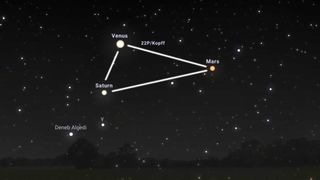Venus, Mars and Saturn form a celestial triangle before dawn: How to see it
You can spot them Sunday and Monday, before sunrise.

You can spot a triangular alignment of three bright worlds Sunday (March 27) and Monday (March 28) in the predawn hours.
Involved in this collection of worlds will be cloudy Venus, bright Mars and ringed Saturn. Also joining them on Monday will be the crescent moon, making this a bright group indeed. You can see this entire collection with the naked eye, but a bit more detail will be visible in binoculars or a telescope.
If you're looking for binoculars or a telescope to see planets in the night sky, check out our guides for the best binoculars and best telescopes. If you need photography equipment, consider our best cameras for astrophotography and best lenses for astrophotography to prepare for the next planet sight.
To see the show, we recommend heading out at least 20 minutes before sunrise in your local region. So in New York City, for example, you will want to head out a little before 6:30 a.m. local time.
Related: The brightest planets in the night sky: How to see them (and when)
If you take a photograph of the planets, let us know! You can send images and comments in to spacephotos@space.com.
Look east, which should be easy to spot, especially on Monday, when the moon is bright in the sky. Venus will be the glittering world at the top 'left' of the triangle, as visible with the naked eye. The clouds surrounding the planet are highly reflective, and the world will shine at roughly -4.7 magnitude.
Slightly below Venus will be Saturn, the great ringed world. Saturn is dimmer right now, at roughly 0.7 magnitude. But you can still easily spot it with the naked eye; bear in mind that most people can see down to magnitude 6 in dark-sky conditions.
Get the Space.com Newsletter
Breaking space news, the latest updates on rocket launches, skywatching events and more!
Finally, Mars will be to the right of both the planets. It's creeping towards magnitude 1 and should be easy to spot, with its red color

As a bonus, you can try to spot Jupiter, although it will be much lower on the horizon (only two degrees above), making it hard to spot among buildings or light pollution. Jupiter is roughly magnitude -2 and may be more visible if you go out a bit earlier in the evening.
Thanks to the ecliptic (the plane of our solar system upon which the planets orbit), we see a lot of planetary alignments like this in our sky. The trio of planets should still be bright in the predawn sky in the coming days, so you can still keep an eye out for them if you miss the alignment due to clouds or scheduling issues.
Follow Elizabeth Howell on Twitter @howellspace. Follow us on Twitter @Spacedotcom or Facebook.
Join our Space Forums to keep talking space on the latest missions, night sky and more! And if you have a news tip, correction or comment, let us know at: community@space.com.

Elizabeth Howell (she/her), Ph.D., is a staff writer in the spaceflight channel since 2022 covering diversity, education and gaming as well. She was contributing writer for Space.com for 10 years before joining full-time. Elizabeth's reporting includes multiple exclusives with the White House and Office of the Vice-President of the United States, an exclusive conversation with aspiring space tourist (and NSYNC bassist) Lance Bass, speaking several times with the International Space Station, witnessing five human spaceflight launches on two continents, flying parabolic, working inside a spacesuit, and participating in a simulated Mars mission. Her latest book, "Why Am I Taller?", is co-written with astronaut Dave Williams. Elizabeth holds a Ph.D. and M.Sc. in Space Studies from the University of North Dakota, a Bachelor of Journalism from Canada's Carleton University and a Bachelor of History from Canada's Athabasca University. Elizabeth is also a post-secondary instructor in communications and science at several institutions since 2015; her experience includes developing and teaching an astronomy course at Canada's Algonquin College (with Indigenous content as well) to more than 1,000 students since 2020. Elizabeth first got interested in space after watching the movie Apollo 13 in 1996, and still wants to be an astronaut someday. Mastodon: https://qoto.org/@howellspace
